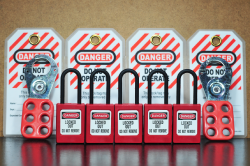Control of Hazardous Energy Sources
Also known as Lockout/Tagout
 OSHA’s standard for The Control of Hazardous Energy — or Lockout/Tagout (LOTO) — addresses practices and procedures the facility operator, need to put into place to disable machinery or equipment with the goal of preventing the
release of hazardous energy while designated employees perform servicing and maintenance activities. All facilities, regardless of size, must implement this program to protect employees, or contractors, from the hazardous energy that may be stored
in the equipment or released if the equipment was inadvertently started while it was being repaired or maintained. Your Lockout/Tagout program will prevent employees from becoming injured from the equipment being turned on or energized while performing
service or repair operations on machinery.
OSHA’s standard for The Control of Hazardous Energy — or Lockout/Tagout (LOTO) — addresses practices and procedures the facility operator, need to put into place to disable machinery or equipment with the goal of preventing the
release of hazardous energy while designated employees perform servicing and maintenance activities. All facilities, regardless of size, must implement this program to protect employees, or contractors, from the hazardous energy that may be stored
in the equipment or released if the equipment was inadvertently started while it was being repaired or maintained. Your Lockout/Tagout program will prevent employees from becoming injured from the equipment being turned on or energized while performing
service or repair operations on machinery.
Under this standard, you are required to develop a formal written program and conduct training based on the program developed. The written program must include specific Lockout/Tagout procedures for each individual machine covered by the standard. Equipment that is completely powered by a single energy source, such as “cord and plug” is exempt from this requirement if the equipment remains under the exclusive control of the person performing the servicing or maintenance. If exclusive control cannot be maintained, the plug needs to be locked out.
PRINTING United Alliance has a written program template that can be used for your program. Your written program must include:
- The department or location of each covered piece of equipment
- Each equipment’s individual ID number
- The energy types and magnitude (e.g. electricity 480-volt 3 phase or 90 psi pneumatic air) found within each piece of identified equipment
- Energy controls/isolation devices on each piece of identified equipment
- Shutdown procedures for each piece of identified equipment
- Stored energy release and restart procedures by specific piece of equipment
- Startup procedures for each piece of identified equipment
- date your program was written, and then subsequent revision dates
Training
Once all the procedures have been written, you can begin to train your employees. All employees will need to be trained to recognize either the lock or tag used for service and maintenance activities. An employees’ interaction with the equipment will determine the level of training required.
Authorized Employees
 Maintenance
personnel, or contractors, who perform the maintenance and servicing activities are defined as ‘authorized employees’ under the standard. These employees receive the most training because they must be trained in how to lockout the equipment,
release any stored energy, test to ensure it is locked out, and how to reenergize the equipment once the servicing or maintenance is completed.
Maintenance
personnel, or contractors, who perform the maintenance and servicing activities are defined as ‘authorized employees’ under the standard. These employees receive the most training because they must be trained in how to lockout the equipment,
release any stored energy, test to ensure it is locked out, and how to reenergize the equipment once the servicing or maintenance is completed.
Affected Employees
Employees who operate or support the operation such as helpers of the machine are defined as ‘affected employees’ and require ‘do not touch’ training while the equipment is locked out. Many affected employees will perform minor servicing and maintenance actives and must be trained in the alternative energy control procedures they are to follow to protect themselves from injury due to inadvertent activation of the equipment. One such method that has been accepted by OSHA is the inch-safe-service method (see below) that is unused in conjunction with equipment that meets the appropriate American National Standards Institute (ANSI) standard that specifies stop/safe/ready control drives and warning and signaling systems.
Other Employees
Employees not part of production floor, such as office personnel, sales, etc., but may enter the production area are defined as ‘other employees’ and require awareness training.
Upon completion of training, each machine specific procedure and each authorized employee for the machine must be reviewed on an annual basis. The purpose is to ensure that the machine specific procedure is still accurate and each ‘authorized employee’ can demonstrate competency that they can follow the established LOTO procedures. If they do not follow them correctly, then they need to be retrained. Retraining may also be necessary if staffing changes occur or you become aware that the employee is not following the established energy control procedure.
Minor Servicing and Maintenance
 For printing equipment, OSHA has determined that routine production procedures like changing/cleaning plates, blankets and screens, clearing paper jams, and making minor adjustments and lubrications are classified as minor servicing or maintenance
activities, and not subject to lockout/tagout control procedures.
For printing equipment, OSHA has determined that routine production procedures like changing/cleaning plates, blankets and screens, clearing paper jams, and making minor adjustments and lubrications are classified as minor servicing or maintenance
activities, and not subject to lockout/tagout control procedures.
Minor servicing and maintenance are the only exception to cutting all power and isolating the equipment. To be considered as minor servicing or maintenance, two conditions must be met:
- The activity is routine, repetitive, and integral to the production process.
- The activity must be performed with alternative equivalent protection. Any alternative protection must be equivalent to the protection offered by having the machine guard in place.
These activities are permitted without cutting power to the equipment if the employee observes the inch-safe-service method. This method involves the proper use of the stop/safe/ready button system as outlined by the American National Standards Institute (ANSI) and not touching a moving part.
The inch-safe-service method requires that the equipment be placed in a safe mode by depressing the stop or stop/safe button before the activity can be performed. If the equipment needs to be moved to provide for further access, then the equipment is advanced and immediately placed in the stop/safe mode. The activity can then be resumed. This sequence is to be followed until the minor servicing or maintenance is completed.
PRINTING United Alliance’s OSHA Compliance Resource Center provides technical assistance and services designed to allow printing operations to manage compliance and stay informed. For more information on Controlling Hazardous Energy Sources or PRINTING United Alliance’s EHS services, email govtaffairs@printing.org or call 888-385-3588.